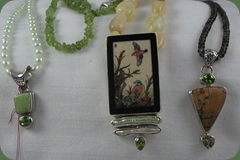I really enjoy starting projects. It may be a new design or just a simple change of beads or shapes that gets my juices flowing, but I hardly want to stop once I begin the work. Then, there’s finishing. Yuk! The expression on Grandson Gabriel’s face says it all.  I DO NOT like to finish the pieces. If I had a factory, someone else would put the clasps, chains and earring findings on my work. Alas, that isn’t going to happen. But there does come a time when you just have to give in and get it done. That has happened twice this week. My client in Maine ordered a number of things several weeks ago and said, “no hurry; I won’t need them for about a month.” I happily began work on the pieces, laying each aside before adding the final touches. Last week, I suddenly realized that the “month” was almost over and I’d better get moving. There they lay . . . all 17 pieces had to be finished. Now, as you can imagine, if one doesn’t enjoy finishing just one piece, finishing 17 is not very invigorating. You’d think I would learn, wouldn’t you? Wrong! Tonight I’ve just finished 9 pair of earrings, five necklaces and a bracelet for tomorrow. All of these were previously designed and made without clasps and earring findings. (The one shown here is my first attempt at wire work with sterling silver. My technique needs help, but I’m pushing ahead.
I DO NOT like to finish the pieces. If I had a factory, someone else would put the clasps, chains and earring findings on my work. Alas, that isn’t going to happen. But there does come a time when you just have to give in and get it done. That has happened twice this week. My client in Maine ordered a number of things several weeks ago and said, “no hurry; I won’t need them for about a month.” I happily began work on the pieces, laying each aside before adding the final touches. Last week, I suddenly realized that the “month” was almost over and I’d better get moving. There they lay . . . all 17 pieces had to be finished. Now, as you can imagine, if one doesn’t enjoy finishing just one piece, finishing 17 is not very invigorating. You’d think I would learn, wouldn’t you? Wrong! Tonight I’ve just finished 9 pair of earrings, five necklaces and a bracelet for tomorrow. All of these were previously designed and made without clasps and earring findings. (The one shown here is my first attempt at wire work with sterling silver. My technique needs help, but I’m pushing ahead. 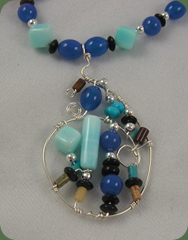 ) This reminds me of when my children wouldn’t finish their term papers until the night before they were due . . . or was it that they didn’t START their term papers until the night before they were due? At any rate, I must endeavor to correct the error of my ways. I actually think that finishing so many projects all at once is enough punishment that I may remember to do better in the future. Or . . . Not.
) This reminds me of when my children wouldn’t finish their term papers until the night before they were due . . . or was it that they didn’t START their term papers until the night before they were due? At any rate, I must endeavor to correct the error of my ways. I actually think that finishing so many projects all at once is enough punishment that I may remember to do better in the future. Or . . . Not.
Technique-Like Riding a Bike
Technique, to this former music teacher, has generally pertained to the basics of musicianship. At the ripe age of 5 years old, I was taught by my second piano teacher, Mrs. Ida Defoe Hardy, (my mother was the first teacher) that if you had good technique and kept practicing your scales, you could learn a piece more quickly and easily. Long ago, when I was young and rule-bound, I did what Mrs. Hardy said and later realized she was right. My good piano technique, curved fingers, strong hands, scale facility, etc. has stayed with me even though I play less frequently.
Yesterday, at the nursing home with my 87 year old mother, I was again reminded about the value of technique. A new organ was donated to the nursing home and Mother has been wanting to play it. I would wager that it has been a minimum of 15-20 years since she touched an organ and with her crooked arthritic fingers, I feared the worst as she approached the keys. Yet, I was the one who got a BIG surprise. Although it wasn’t perfect, the music was recognizable, the rhythm consistent and the smile on another resident’s face as she listened to Mother was genuine.While I was pleased with the sound, I was even more impressed with Mother’s technique. Her crooked fingers were curved as she sat up straight. In organ lessons, we learn to lay the thumb on its side in order to depress two keys at the same time while reaching other fingers to far away keys. Mother did this repeatedly without consciously thinking about it. I guess good TECHNIQUE lingers for years. It IS like riding a bicycle; you never forget it. The longer we’ve practiced a technique, the better the skill, and the less likely we are to lose it. (Isn’t this why elementary school teachers urge parents to keep their young readers in the print through the summer months? The more unskilled the reader, the more they lose through idleness. Adults, don’t have to do this because our skill is fully developed.)
Design work certainly requires technique as well. We practice the basics such as crimping, making a wire spiral, etc. repeatedly and these become so natural that we are free to think of other elements. As a beginner, I wanted to be creative and add my own style, but there were many disasters largely because I didn’t have the basic skills perfected. Now, years later, many of those techniques are natural and my brain is free to consider other things. There must be a lesson here! I think my guide should be that when learning a new element (currently, the element is how to make my own wire clasps), I should practice until the process becomes more a part of my technique before deciding to alter it. I don’t like doing the same thing over and over, but in the case of basic technique, it is needed.
I can still hear Mrs. Hardy saying, as I later told my own students, you can’t improvise on Bach until you can play it the way he wrote it! OK Mrs. Hardy, I think I’ve finally got it!
Fluency . . .
the ability to produce a quantity of ideas, answers, or problem solutions (Meador, 1996)
Having spent a good 15 years of my life trying to teach others about creative thinking, today I’m working with the concept of fluency. It’s the first “F” of FFOE commonly referred to in creativity literature. FFOE represents fluency, flexibility, originality and elaboration upon which most creative activities are based. Initially, I studied these in writing my masters thesis and preparing activities to improve areas of challenge for creative thinkers. We utilized those activities for many years in working with adolescent Creative Scholars in summer programs in Louisiana. Later, I continued to study FFOE during dissertation work and the writing of Synectics activities for Kindergarten children. Following years involved training teachers to help students think more creatively as well as writing books and articles to help them (see publications list: http://www.dreamcatcherranch.net/consulting/publications.htm)
Today, I’m struck by the fact that all that study and work has submerged itself only to erupt in the design work (I wonder if it helps with the ranch work . . . ?). Whether consciously or subconsciously, I’m using FFOE every day.
Experts tell us that fluency is needed to help us explore all possibilities in an effort to find the most suitable one. But what if the best one came first? We wouldn’t know it was best without the propagation of others. But isn’t fluency a waste of time? It doesn’t waste as much time as completing an idea that didn’t work. (Yes, I do this too often as evidenced by a basket full of UFOs, unfinished objects.)
In an effort to be fluent today, I’ve added a gallery section to this blog which displays a quantity of ideas. It will continue to grow as more photos are uploaded.
Overdone Reversal
I do not like to make earrings. For years, I’ve mostly made only those that matched a customer’s necklace, but lately a reversal of that phenomenon has occurred. Two things dawned that perpetuated this reversal. First, my friend and wholesale vendor, Szarka (www.magpiegemstones.com) encouraged me to purchase Lindstrom tools for wirework saying they would improve my efforts and ease the hand strain. Unlike many vendors, who may recommend something because they sell it, she doesn’t even have these for purchase; so I took her advise. A good many dollars later, I had the precious tools. My justification was that if the guys on the ranch could have a hydraulic squeeze chute at the barn then surely I could have some good tools. (I only purchased 3 tools and we’re not going to compare cost of tools vs chute unless it becomes necessary!) With new tools in hand, I started working on earrings. It was actually fun, the ideas kept flowing and Szarka was right about the value of the right tool.
The second thing that encouraged this reversal is that someone purchased 3 pairs of the new designs. (No that doesn’t even pay for one tool!) Thinking that there may be potential in creating earrings, I’m on my way. The problem may be that I’ve OVERDONE this reversal of my previous behavior. I just keep making earrings. I guess I’m like my Father who never made just one something in his woodworking shop. He made several and then Mother wondered what to do with them all. The picture at the bottom shows a mere fraction of what I’ve created in the past few days. I’ve even run out of ear wires. I guess I’m just going to have to go out looking for people with holes in their ears and show them the new designs. The good thing is that at least I’ve been working with less expensive copper. Perhaps I’ll be more frugal when I’m using sterling silver. Anyone out there need earrings?
Medford is Coming
I grew up in Medford, Oklahoma near the border of Kansas. When my family purchased our first home, my Daddy planted a redbud tree just outside my bedroom window. The winter was really cold in Medford, but the first harbinger of Spring was the blooming of my redbud tree. Upon moving into our current ranch house, my husband planted the redbud tree pictured at the left just outside our den window. Although I’ll take the South Texas winters hands down over the Northern Oklahoma winters, I’ll keep the redbud tree as my sign that Spring is coming. When that tree blooms it still says “Medford” to me.
In honor of the beautiful color of the tree, I made two necklaces. While neither can truly capture nature, they were a pleasure to make as I thought about days long past.
Too Much Turquoise?
For years I’ve used considerable turquoise in my designs. At the end of each season, when I examine my seller’s case to see what is left, I usually find that all the turquoise pieces have gone to happy homes. Also, at the end of each season, I think, “well that was a good run for turquoise, but I’d better find the next best stone for this season.” That’s MISTAKE #1! Turquoise is always a preferred stone.  When working with customers, I often make MISTAKE #2. If a person says that he or she has plenty of turquoise, I believe it. WRONG. I don’t think you can have TOO MUCH turquoise. That person probably just needs turquoise from a different mine, in a different length or designed in a new style. Rather than taking it for granted that a person has, as stated, too much turquoise, the next time I’m going to ask for an opinion about a particular new design in turquoise that I’ve created.
When working with customers, I often make MISTAKE #2. If a person says that he or she has plenty of turquoise, I believe it. WRONG. I don’t think you can have TOO MUCH turquoise. That person probably just needs turquoise from a different mine, in a different length or designed in a new style. Rather than taking it for granted that a person has, as stated, too much turquoise, the next time I’m going to ask for an opinion about a particular new design in turquoise that I’ve created. 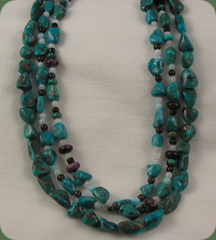 Maybe I’ll be surprised to see that new design go home with the person because there’s no such thing as . . .
Maybe I’ll be surprised to see that new design go home with the person because there’s no such thing as . . .
TOO MUCH TURQUOISE!
Opposites
I’m struck today by the many opposites in my environment and wondering how that context might fit into the design work. The picture at the left is analogous to hiding money under your mattress. The two nitrogen tanks filled with valuable embryos collected from our donor cows sits in the living room with the grand piano. If I thought it would make the embryos any more viable, I would play them special music. But the tanks were not placed in this room for nurturing, rather they are there due to the value of their contents.
While the idea of opposites in design work is not unique and today this thought might lead to pearls and metal in a piece, I’m gleaning a different message. Opposites (as opposed to opposition) may be good for the designer. For example, I’m a rancher by day and beader by night. When I’m covered in “it” from ranch work by day, I know that my opposite time will arrive after supper. When the designs don’t go well at night, I can remember my opposite day work and be thankful that at the least I accomplished feeding the animals and getting the data into the computer.
The dichotomous parts of our lives enrich each other. Certainly elements of shapes, colors and textures from my day creep into the design work at night making the pieces more interesting. On the opposite side, hopefully we will never find beads handing round a cow’s neck.
Do opposites attract? I don’t know; but I do believe that opposites are good for the designer. When I’m totally stuck on a design idea, I may go outside and throw the ball for the heelers or bottle feed a calf. Going in an opposite direction helps clear my head and free my mind for problem solving.
Inspired Color Bursts
I met The Doll Maker quite by chance at a church bazaar in December of 2008. Since then, I have thoroughly enjoyed reading her monthly newsletter complete with outstanding color photos of her adventures. The Doll Maker has given me permission to list a link to the newsletter found at http://weepeeple.com/news/february2009newsletter.htm . The February installment features pictures from her trip to Mexico and displays a wonderful array of bright colors. I think the artisans in Mexico use the “no fear” color method where almost anything works together and I especially I like the way vibrant colors paint the landscape. Inspired by the pictures from Mexico, I decided to “paint” a necklace using bead embroidery.  The embroidered circles use electric blue and shades of orange seed beads stitched on Lacy’s Stiff Stuff and backed with Ultrasuede. I jumped right into this project without a suitable answer regarding how to attach the embroidered pieces to the necklace. I believe that part of the creative process is continuing the work when no plausible answer to a problem is visible. It’s been hard to learn to trust that an answer will be conjured, however, I ’m learning to trust myself. After I completed all the pieces, they spent several days on the design table staring at me as if to say “now what?” Finally, it dawned on me that I could stitch a couple of small beads on the back of each circle and thread the necklace wire through these.
The embroidered circles use electric blue and shades of orange seed beads stitched on Lacy’s Stiff Stuff and backed with Ultrasuede. I jumped right into this project without a suitable answer regarding how to attach the embroidered pieces to the necklace. I believe that part of the creative process is continuing the work when no plausible answer to a problem is visible. It’s been hard to learn to trust that an answer will be conjured, however, I ’m learning to trust myself. After I completed all the pieces, they spent several days on the design table staring at me as if to say “now what?” Finally, it dawned on me that I could stitch a couple of small beads on the back of each circle and thread the necklace wire through these. 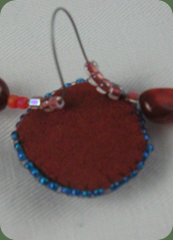 I added a few extra beads in order that the wire would be hidden on the back of each piece. While I can’t attest to whether or not my customers will like this style, I can be assured that I learned from creating it.
I added a few extra beads in order that the wire would be hidden on the back of each piece. While I can’t attest to whether or not my customers will like this style, I can be assured that I learned from creating it.
Color Success
The picture shows the pendants, mentioned in the last blog entry, for which I was making strands. I regret the picture cannot show the beauty of the pendants and the vivid colors. The strands from left to right are pearls, peridot chips, African opals and smoky quartz. Although you cannot see clearly, each pendant has some peridot in it and each is removable for placing on an alternative strand or silver chain. The extra peridot chip strand can be used with any of the pendants or various strands can be put together for a multistrand look. These pieces will be available at Dovetails of Wimberley.
Perfect Light
The title of the entry sounds as though something philosophical should appear in the words that follow. Alas, this is not necessarily the case. I’ve put off preparing and returning the necklaces for several pendants given me by a retailer. Yet, there comes a time when you can wait no longer and this is the day. Unfortunately, this day started dark and drizzly – not a good combination for selecting matching colors for the pendants. Realizing that I’m working with greens today, you may wish to nod your head in understanding.
Although I arranged what seemed to be good color matches, I was about to give up on the process for lack of clear light and the clarity it brings. Then it dawned! The perfect sunlight crept over my shoulder to shine directly on the pendants and provide an opportunity to find a beautiful match. 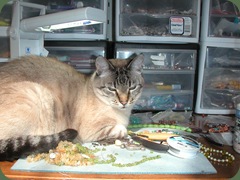 You can see from the picture that sunlight wasn’t the only thing that crept over my shoulder. I guess my cat Blue thought the sunlight arrived solely to warm his back. Luckily, as the sun moved on, so did Blue. Unluckily, I needed the sun back WITHOUT the cat! I’m thankful that I was able to quickly grab the right colors for the pendants even in the midst of the brief sunlight and the warming cat. Perhaps a few rays of sunlight once in a while is all I need.
You can see from the picture that sunlight wasn’t the only thing that crept over my shoulder. I guess my cat Blue thought the sunlight arrived solely to warm his back. Luckily, as the sun moved on, so did Blue. Unluckily, I needed the sun back WITHOUT the cat! I’m thankful that I was able to quickly grab the right colors for the pendants even in the midst of the brief sunlight and the warming cat. Perhaps a few rays of sunlight once in a while is all I need.
Philosophical Query: As we wait for clarity on things much more important that designs, do we need to be prepared to capture that fleeting moment of clarity as it passes us by? Is that moment sometimes hidden by some distraction?





